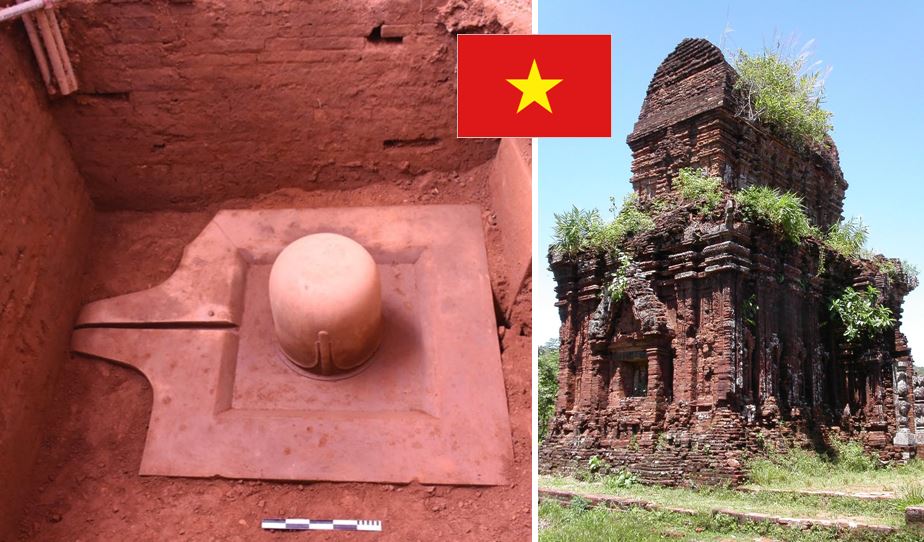In a development that has reaffirmed the extent of Hindu civilization in the past, the Archaeological Survey of India has unearthed an 1100-year-old (approximately) sandstone Shiv Lingam in Vietnam. The discovery of the monolithic Shiv Lingam has come in the backdrop of India undertaking tremendous conservation and restoration works in the Cham Temple complex in Mỹ Sơn city — where partially ruined Hindu temples are found in abundance. The site is located in Quảng Nam province of central Vietnam.
Informing the world about the discovery, MEA Dr. S Jaishankar took to Twitter and said the artifact reaffirmed the strong-civilizational connect between ancient India and Vietnam.
A great cultural example of India’s development partnership. @AmbHanoi @ITECnetwork
@FMPhamBinhMinh pic.twitter.com/9kB6DZ8MbK— Dr. S. Jaishankar (Modi Ka Parivar) (@DrSJaishankar) May 27, 2020
The 9th-century Shiv Lingam is said to have been consecrated during the reign of Raja Indravarman II of the Khmer Empire. Earlier, the four-member team of ASI conducting restoration work in the same temple cluster complex had discovered six other Shiv Linga’s. Mỹ Sơn sanctuary in Vietnam is a designated UNESCO world heritage centre and houses a cluster of Hindu temples built over a period of 10 centuries. In the words of UNESCO, a unique culture that traces its origins back to Indian Hinduism developed on the coast of contemporary Vietnam.
According to a report by Hindustan Times, a four-member team of the ASI has been engaged in restoration work in the Cham Temple complex in Vietnam. Over the past three seasons, ASI has restored temples in two different groups at the complex, and the team is now working on a third group of temples.
“During the current restoration work at the temples, the ASI team found the Shiv Linga. It is a monolithic structure with decorative patterns of very exquisite cultural value,” an official told HT. He further added that six Shiv Lingas were indeed discovered from the complex, although the latest find was the most magnificent till date.
Bharat had a profound impact on the culture of Southeast Asia, where petty clan Chieftain was introduced to the sovereign nature of rule by Hindus, thus transforming them into Rajas and Maharajas of kingdoms. With this transformation came the acceptance of the Hindu way of life and spiritual thought, leading to a spread of our culture paralleled perhaps to no other in those times.
Indonesia, Malaysia, Maldives, Vietnam, Philippines, Cambodia, Thailand, and other nations have had an unprecedented impact of Hinduism, whether it be pure Shaivite in nature, or a conglomeration of fundamental Hindu thoughts with the pagan culture of the regions.
According to the official website of the Vietnam National Administration of Tourism, “Many of their shrines honour Shiva—often shown as a linga, while their carvings depict all manner of Hindu deities. Hindu doctrines were blended with homegrown beliefs, such as their conviction that they were descended from a goddess named Po Nagar, born from heavenly clouds and seafoam.”
The cultural footprints of Hindu civilization are overtly visible to this very day in Indonesia, Maldives, Malaysia and other Southeast Asian countries. Hinduism is said to have reached Indonesia as early as the 1st century CE, following which the masses were adherents to the Hindu thought, until the arrival of Islam in the 15-16th century CE, which then overtook as the majority religion. Notably, the National Indonesian Bureau of Statistics admitted in 1999 that around 100,000 people had officially converted or ‘reconverted’ from Islam to Hinduism over the previous two decades.
The most profound impact that Hindu civilization has had on Southeast Asia is perhaps the fact that it has prevented a homogeneity of thought from taking over the minds of the people. As a result of which, while Islam may definitely be the majority religion in countries like Indonesia and Malaysia, among others, their people have not forgotten their Hindu roots.
The unearthing of the magnificent sandstone Shiv Lingam in Vietnam stands as a testimony to the extent of Hindu civilization. While Southeast Asian nations were profoundly impacted by the Hindu thought, back here in India, the same is not a part of school curricula. This makes students believe that the ancient Bharat was a single civilization with no outward influence or impact, which in the long run also goes a long way in making them look up to other expansive civilizations as ‘glorious’, even as they do not shy away from deriding Hindu culture.
Read: After unleashing coronavirus in the world, China is preparing to starve Laos, Vietnam and Cambodia
Read: Recent developments reaffirm India’s relations with Vietnam
Read: Vietnam’s bold stance in the face of China’s aggression is making the Chinese very nervous
The extent to which Hinduism spread in Asia, despite Bharat being a non-expansive culture (politically), goes on to show that the acceptance of the Hindu way of life among large swathes of populations came due to the richness of our culture, and not because it was shoved down their throats by force.
